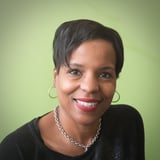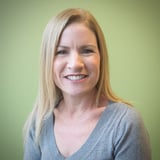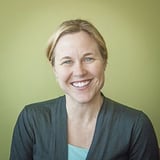
When I began looking for a child care program for my daughter, I was confident I would find the best school for her and that my years at Teachstone would guide me in finding the perfect program. It wasn’t that easy.
I pulled a list of programs nearby and their star ratings and began touring the “highest quality” programs—the programs with four and five stars. What was interesting (and actually pretty frustrating) was that the quality of the interactions I observed during my walkthroughs was so different even though the programs all had the same star rating. I realized very quickly how there isn’t one standard definition of quality, but also how important interactions were to me and the type of program I wanted for my child. I ended up finding a fantastic program where the teachers are really invested in her development and provide a warm and supportive environment for her. It’s really nice to know that while I can’t be with her during the day, she is safe, happy, and thriving.
But this process also got me thinking about how people find programs that work for them and their children. Given the quality differences in the schools I looked at, do the star rating systems really give parents the information they need to pick the right program for their children? I recently read a blog post from TNTP about How Education Pros Pick Schools for Their Kids and wanted to know what other Teachstone staff looked for when choosing a school. Here’s what they all had to say:
 Lisa Rogoff (Marketing):
Lisa Rogoff (Marketing):
I'm embarrassed. Even after working at Teachstone for more than two years and fully understanding the importance of high quality teacher-child interactions, I hardly used this knowledge at all to pick a child care center for my son. I chose Oliver's center based on, drum roll ... convenience (it's right on my way to work and next door to my husband's job), hours (it's open 6 a.m. - 6 p.m.), and cost (it's not cheap, but it's subsidized by my husband's job, so compared to what it could be, it's a deal). These are all of the factors that we know influence child care decisions across the board, but they are also the factors that we know do not influence outcomes. I'm lucky. My son's center (and now my daughter, Maddy's as well!) is awesome. The teachers are amazing and I have seen both of my children thrive in their classrooms. The center has welcomed my husband and me with open arms, and I've learned so much about being a parent from the time I've spent talking with the caregivers. While I'm not proud of the factors that led to my decision, I am thrilled that it worked out. At the same time, I know how many kids this doesn't work out for, and this breaks my heart. Oliver and Maddy are fortunate—and to be honest, I think they would be thriving even if they were at a lower quality center—but we know that so many children who really need these high quality interactions from their caregivers don't have access to them.
 Othondra (O.T.) Hicks (Trainer):
Othondra (O.T.) Hicks (Trainer):
Parents have various preferences on what they expect for their child or children's education and what they wantt their children to gain from education. For me, I factor the following: the school/child care environment; teacher education and experience; and what the school goals are in the success of children's education.
I wanted to make sure my child felt safe and secure when they attend school or childcare. I wanted to ensure that the environment was inviting and suitable—this meant looking beyond the pretty pictures and posters on the wall. Just because the classroom or the school looks beautiful does not mean that it's a suitable environment for your child.
Teacher education was also important to me. I asked if the teachers had a degree in education, early childhood, special education, or a specialized degree working with children. I noted if the teachers were patient, had an understanding of children's challenges, was willing to work with a child, and if they went beyond the call of duty to educate. I also wanted to know if the teacher was up-to-date on the latest trends in education. Those factors could all be beneficial to your child's development in learning important skills for success.
The school's goals were also important to me. As a parent, you need to understand the steps that the school is taking to ensure that children receive the best education and support. What steps does the school take to ensure parents are aware of their child's progress/challenges? Does the school allow parents to be part of the decision making of factors like curriculum, staff, etc? Does the school allow me to be that key partner?
Do your research before sending your child or children to a school or childcare facility that may not be healthy or suitable for them. It's up to you to ensure that they receive quality education and aren't just pushed along.
 Deirdre "Dee" Manley (Trainer):
Deirdre "Dee" Manley (Trainer):
When looking at elementary schools, I requested information from the school board about the grade the "school of choice" was provided at the end of each testing year. I also wanted to learn more about all the extracurricular activities offered to children, and any additional resources available for parents.
 Gina Gates (Professional Development):
Gina Gates (Professional Development):
When I began the process of selecting a preschool for my daughters, now ages 10 and 12, I started by checking out the NAEYC site and seeing which schools in my area were accredited. Since it was new to me I felt this was a good starting point on selecting a quality school. I was a stay-at-home mom at the time, not looking for full-time care, but instead I was looking to find a place where my children would be loved and accepted—a place where they could develop important social skills, and a place where they could be challenged to further their thinking. I visited many schools, seven to be exact, before I found the "right" one. I visited many schools that had all the bells and whistles, but in the end, I picked a preschool where student-teacher interactions and a positive environment were evident. I had friends who picked those "bells and whistles schools" and shortly thereafter pulled them out only to enroll them where we were. It was an older center that had smaller classrooms and did not have all the latest technology. But what I found was a place where teachers were sitting with children on the floor, talking to them, hugging them when they needed comfort, and valued play. I didn't focus on whether or not my children would leave there reading, or how many sight words they knew, or if they could count by 10s. I wanted a place that would engage them to the point that they would love school, love to learn, love to play, and love to be good people. Each of my daughters spent two and a half years there, and it was the best decision I ever made.
 Amy Stephens Cubbage (Research and Policy):
Amy Stephens Cubbage (Research and Policy):
Coming from my Worthy Wages perspective and my understanding of the research showing consistently better outcomes for children in schools where teachers are well-compensated, I’ve always asked the tough questions of administrators about the compensation of teachers in their schools or other ECE programs before enrolling my kids.
I believe the secret to great schools is great teachers who are well-trained, well-compensated, and well-respected. Usually these all go hand in hand.
It's not enough to wish that teachers were paid more. When I ask these questions, it puts the administrators on notice that they have a parent/family that cares deeply about the well-being of the teachers who teach their children, and that I put it front and center in my evaluation of the best schools for my kids.
 Morgan Walker (Technology):
Morgan Walker (Technology):
When searching for childcare for our daughter, Vivian, we started with the experts—Teachstone! I asked around the office to find out which daycare centers in Charlottesville City were worth touring. After we were given some suggestions we started visiting different centers. In each center, we noted the teacher:infant ratio, teacher turnover, teacher education and professional development, how teachers respond to babies' cues, the items that parents are asked to provide on a day-to-day basis (food, blankets, diapers, etc.), how parents are kept informed of daily activities, and how the center handles the transition from infant to toddler, and so on.
We also wanted to know which educational philosophies (if any) each center practiced. We were looking for a Reggio-Emilia inspired daycare. This led us to Our Neighborhood Child Development Center. Upon visiting ONCDC, we learned that they also practiced Conscious Discipline, which we were unfamiliar with. After further investigation and considering the aforementioned criteria, we knew ONCDC was the right pick for our family—and we couldn't be happier. Vivian has blossomed at ONCDC, and we, as parents, have learned new ways of caring for our baby and now toddler.
 Vicki Kintner-Duffy (Professional Development):
Vicki Kintner-Duffy (Professional Development):
I was three months pregnant with my daughter when we moved to Memphis and wasn’t quite sure where to start beyond getting her on the waiting list for the university lab school. I knew about child care resource and referral agencies, so I started there to get an idea of what programs were close to us and which ones had infant/toddler classrooms. I also looked at Tennessee’s Star-Quality (QRIS) website to learn more about how the programs were licensed, supported, and rated. Although these helped me get a picture of what might be available, I will say that they were overwhelming and a little difficult to navigate—even for an ECE professional. Thankfully, we were also making friends who had young kids. We talked to several parents and narrowed it down to three schools to go visit.
During the visits, I looked for several things:
- The warmth of the environment. Were the teachers welcoming to me and respectful to the children in the classroom?
- The daily schedule. How much time did the children spend in play? Were their inappropriate expectations of group time for infants/toddlers?
- The responsiveness of the teachers… Did they notice the children that needed attention and respond to them quickly?
- The art and displays on the walls. Was everything cookie-cutter or was there some unique variety?
- The materials in the classroom. Were they accessible to the children? Were they interesting and engaging?
- The language going on. Were the teachers talking to the children and following the children’s ideas and interests?
- The diversity in the classroom. Were there children of varying ethnicities, abilities, languages, etc.?
- The outdoor environment. Was the outdoors an inviting and interesting place to go? How often did they go outside?
Using my list of questions and, yes, even my gut as a guide, we finally found a Reggio-Emilia based program that we liked. My daughter has now been there almost two years and will run up and hug her teachers when she sees them. I know her curiosity and independent spirit are being nurtured there.
We were privileged to be able to make this decision for our daughter as it is more expensive than some programs, has limited hours (she goes 8:00 a.m. to 3:00 p.m. each day), and had a space available at the right time. I think it is important to note that not everyone has such options, so we as parents and professionals need to keep speaking out about the need for all families to have access to quality, affordable child care.
While I read through my coworker’s responses, I remembered this blog post from our CEO, Rebecca Berlin about How to Define Quality. Even within the same company, we are looking for different things when deciding on a school for our children and it brought home the importance and need for a standard definition of quality and a way to measure it.
What do you look for when deciding on where to send your children? What resources have you used to help you make the decision?

